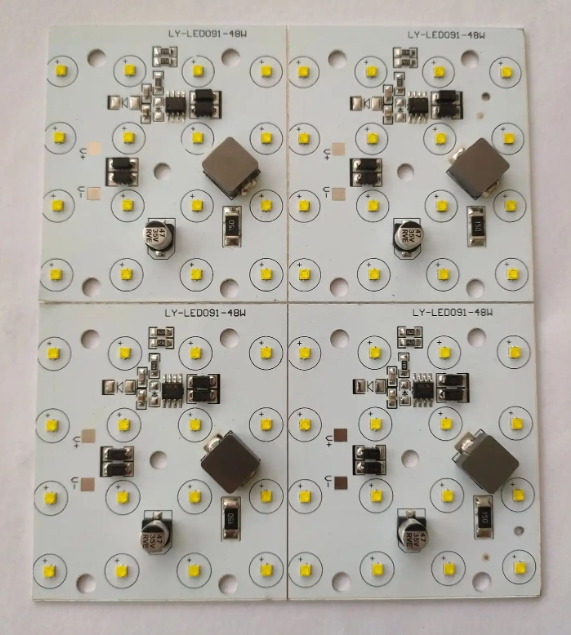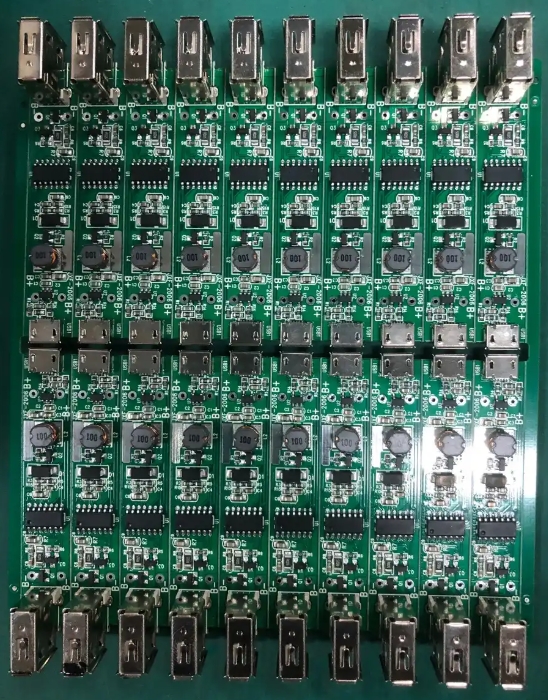Table of Contents
1. What is an LED Light Panel?
An LED light panel is a circuit board that uses light-emitting diodes (LEDs) as its light source. It is a crucial component in electronic devices, transmitting electrical signals and power through circuits and connectors to achieve illumination.
LED light panels are compact in design and highly integrated with multiple electronic components and circuits, making the design and manufacturing process more efficient. LEDs are soldered onto printed circuit boards (PCBs) and equipped with a chip that generates light through electrical connections. A heat sink and ceramic base are used to connect the chip. Undoubtedly, LED PCBs are the core of LED lighting. An LED PCB can generate significant heat, which is difficult to dissipate using traditional methods. Metal-core PCBs, known for their superior heat dissipation capabilities, are widely used in LED applications, particularly those made of aluminum. Typically, an aluminum PCB includes a thin layer of thermally conductive material that transfers and dissipates heat far more efficiently than traditional rigid PCBs.
Currently, surface-mount device (SMD) packaging is the most widely used form in LED applications. Generally, a single LED component emits limited light, so multiple LED components are used in a single fixture to achieve sufficient brightness. Like other semiconductor devices, PCBs are the best way to electrically connect LED components. PCBs with LED components are commonly referred to as “LED PCBs.”

2. Advantages of LED Light Panels
LED light panels offer significant performance advantages in the lighting industry. They are highly integrated, allowing multiple electronic components and circuits to be housed in a compact board structure, simplifying the design and manufacturing process while improving efficiency.
LED light panels also provide high design flexibility, enabling customization to meet various lighting requirements and application scenarios. Their reliability is another key strength. Manufactured using professional PCB processes, they ensure stable electrical connections and can withstand harsh environmental conditions such as high temperatures, humidity, and mechanical shocks, with protective measures in place for long-term stable operation.
Additionally, LED light panels are energy-efficient and environmentally friendly. LED light sources consume less power and have a long lifespan, often exceeding 50,000 hours, without containing harmful substances like mercury. Compared to traditional lighting, they save energy and reduce environmental pollution. Their structural and component design also makes them easy to maintain and install. If replacement or repair is needed, components can be quickly disassembled and replaced, minimizing downtime and maintenance costs.
3. How to Identify High-Quality LED Light Panels
- PCB Material: High-quality LED light panels typically use double-sided fiberglass PCBs, which, although more expensive, ensure durability. Avoid cheap flame-retardant paper boards or single-sided fiberglass boards, as they are prone to moisture damage, oxidation, or breakage.
- IC Brand Consistency: Check whether the IC chips are from the same brand and how many are used. High-quality panels usually use consistent, well-known IC brands in sufficient quantities, ensuring stability and performance.
- LED Chips and Quality: Premium LED chips undergo extensive aging tests, resulting in minimal light decay and extended lifespan. Observe the uniformity of light emission and the brand of the chips—high-quality LEDs provide even illumination without glare, and reputable chip brands indicate better reliability.
- Compatibility: Ensure the LED light panel is compatible with existing equipment. Verify interface types, voltage, and current specifications to avoid operational issues.
4. Common Types of LED Light Panels
LED light panels are mainly categorized into flexible, rigid, and COB (Chip-on-Board) panels. Flexible panels are bendable, ideal for creative lighting designs; rigid panels offer stability for fixed installations; and COB panels provide uniform light distribution, making them suitable for high-end lighting applications.
5. Applications of LED PCBs
LED PCB lights offer exceptional energy efficiency, low cost, and maximum design flexibility, making them suitable for numerous lighting applications:
- Telecommunications: LED indicators and displays are widely used in telecom equipment due to their mechanical robustness and excellent heat dissipation. Aluminum-based LED PCBs play a crucial role here.
- Automotive: Aluminum LED PCBs are used in car signal lights, brake lights, headlights, and other applications. Their durability and cost-effectiveness make them ideal for the automotive industry.
- Computers: LED displays and indicators are increasingly popular in computing. Given the heat sensitivity of computer hardware, aluminum LED PCBs are an optimal solution. They are also used in power supplies and CPU boards for their superior heat dissipation.
- Medical: High-power LED lights used in surgical and diagnostic tools often rely on aluminum PCBs for their durability and heat transfer capabilities, ensuring reliable operation in medical settings. Beyond lighting, medical scanning technologies also frequently use aluminum PCBs.
6. How to Choose the Right LED Light Panel
When selecting an LED light panel, consider brightness (lumens), color temperature (Kelvin), color rendering index (CRI), and waterproof rating (IP rating). Choose the appropriate type and specifications based on the intended application to ensure optimal performance and durability.
7. Future Trends in LED Light Panels
In the future, LED light panels will evolve toward higher luminous efficiency, smarter controls, and thinner designs. Innovations such as intelligent dimming, IoT integration, and foldable LED technology will drive industry trends.
Conclusion
LED light panels have become the preferred choice for modern lighting due to their energy efficiency, high performance, and versatility. Whether for residential, commercial, or industrial use, selecting the right LED panel can significantly enhance lighting quality and energy savings. With ongoing technological advancements, LED light panels will find even broader applications, unlocking new possibilities for the future of lighting.
